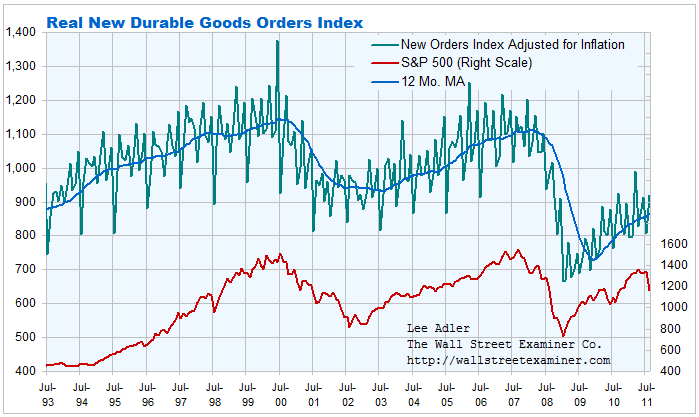Courtesy of Lee Adler of the Wall Street Examiner
 "Orders for U.S. capital goods climbed in August by the most in three months, a sign business investment continues to support the recovery," shouted Bloomberg today on news that durable goods orders rose in August. Citing the seasonally adjusted data, like Bloomberg, Marketwatch took a much more nuanced approach, "Orders for U.S. durable goods fell slightly in August as demand shrank for motor vehicles and certain large defense goods." Confusing? Both news outlets were using seasonally adjusted data, but Bloomberg was reporting a subset of the numbers.
"Orders for U.S. capital goods climbed in August by the most in three months, a sign business investment continues to support the recovery," shouted Bloomberg today on news that durable goods orders rose in August. Citing the seasonally adjusted data, like Bloomberg, Marketwatch took a much more nuanced approach, "Orders for U.S. durable goods fell slightly in August as demand shrank for motor vehicles and certain large defense goods." Confusing? Both news outlets were using seasonally adjusted data, but Bloomberg was reporting a subset of the numbers.
The real story is complicated, but let’s start by dispensing with the seasonally smoothed fiction, which is where everyone else is. It’s hard to know what’s going on when you are looking at a fake number that has nothing to do with actual performance. Actual new durable goods orders were up by 13.6% in August versus July. The year to year gain versus August 2010 was an impressive 14.1%. Excluding Defense capital goods, the monthly increase was 12.9%. The year to year gain was 15.3%.
The year to year gain was very strong. To put the monthly gains in perspective it’s necessary to look at past Augusts. This year was better than last year, when the gains were 9.1% for total orders and 8.8% for non-defense orders. In the recession years of 2008 and 2009, the August gains were in the 4-6% range. Gains in the bubble years of 2005 and 2006 were in the 15-22% range and in 2003 and 2004 they were around 12-13%. In context then, this year looks like a pretty typical expansion with solid growth.
But that’s a long way from being evidence of "recovery." First of all, according to the BEA’s "GDP and the Economy," durable goods manufacturing represents just 7.6% of US GDP. Manufacturing, especially boosted by export sales, can be doing fine while the rest of the economy sucks. Taking a strong durable goods report as evidence of broader economic recovery requires a leap of faith that durable goods manufacturing somehow drives the US economy. Obviously, we all know that expansion of debt and financial chicanery are (or at least were) the key drivers of the US economy. And those things have limits as we have learned all too well.
In fact, unlike some economic data, durable goods orders over the last couple of cycles have followed stock prices by a couple of months. Those who make purchase decisions apparently take their cues from stock prices. If this cycle is typical, given the falling stock market, durable goods orders are likely to start tanking in the next month or two.
The government’s durable goods data is reported in nominal terms. It does not adjust for inflation. It’s important to look at the big picture in real terms by using the CPI to adjust the nominal data (and before you start complaining about CPI, yes, I am aware that CPI probably understates true inflation). The chart of a CPI adjusted index of durable goods orders reveals a few amazing facts. First, the so called "recovery" in durable goods in the last 2 1/2 years has "recovered" just 42% of the decline from 2006 to 2009. Real orders are still 20% below August 2007 and 6.5% below August 2008. In fact, the current level is below every year since 1993 with the exception of the last 2 years. The figures for non-defense durable goods are comparable.
Given that durable goods orders tend to lag major changes of direction in stock prices, regardless of what this sector of the economy does, it won’t help us to forecast the performance of the stock market.
A secondary question is whether it’s of any use in measuring and forecasting the performance of the economy. Here the message is mixed. It is well known that durable goods manufacturing (like housing) is increasingly less relevant to the overall economy. It’s clear from examining this data in real, inflation adjusted terms, that the situation isn’t getting better. Barring a miracle, the current "recovery" in this segment will fall short of the last cyclical peak, as that one fell short of the prior one. In that sense, manufacturing in the US is in a secular bear market and there’s nothing on the horizon that is likely to change that. It is not, and will not be, a meaningful contributor to any economic recovery.
In fact, the decline of manufacturing coupled with the decline of the housing industry, leads to the biggest question of all. Just what will lead to a real, durable US recovery?
For more by Lee, try the Wall Street Examiner Professional Edition risk free for 30 days.
Pic credit: Neptune Salad



